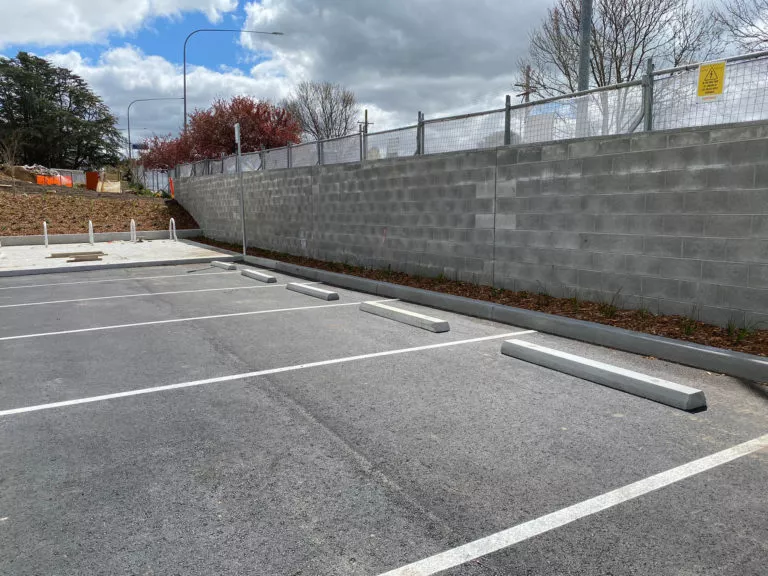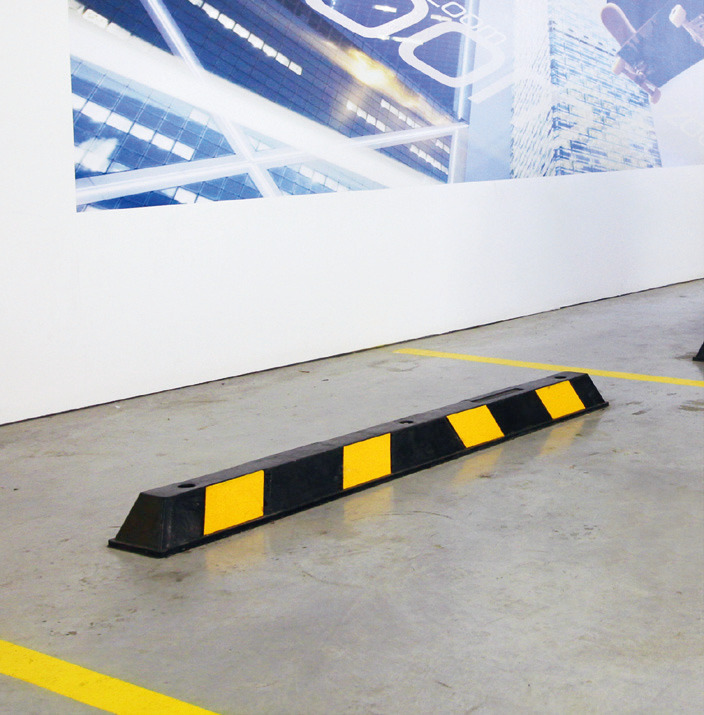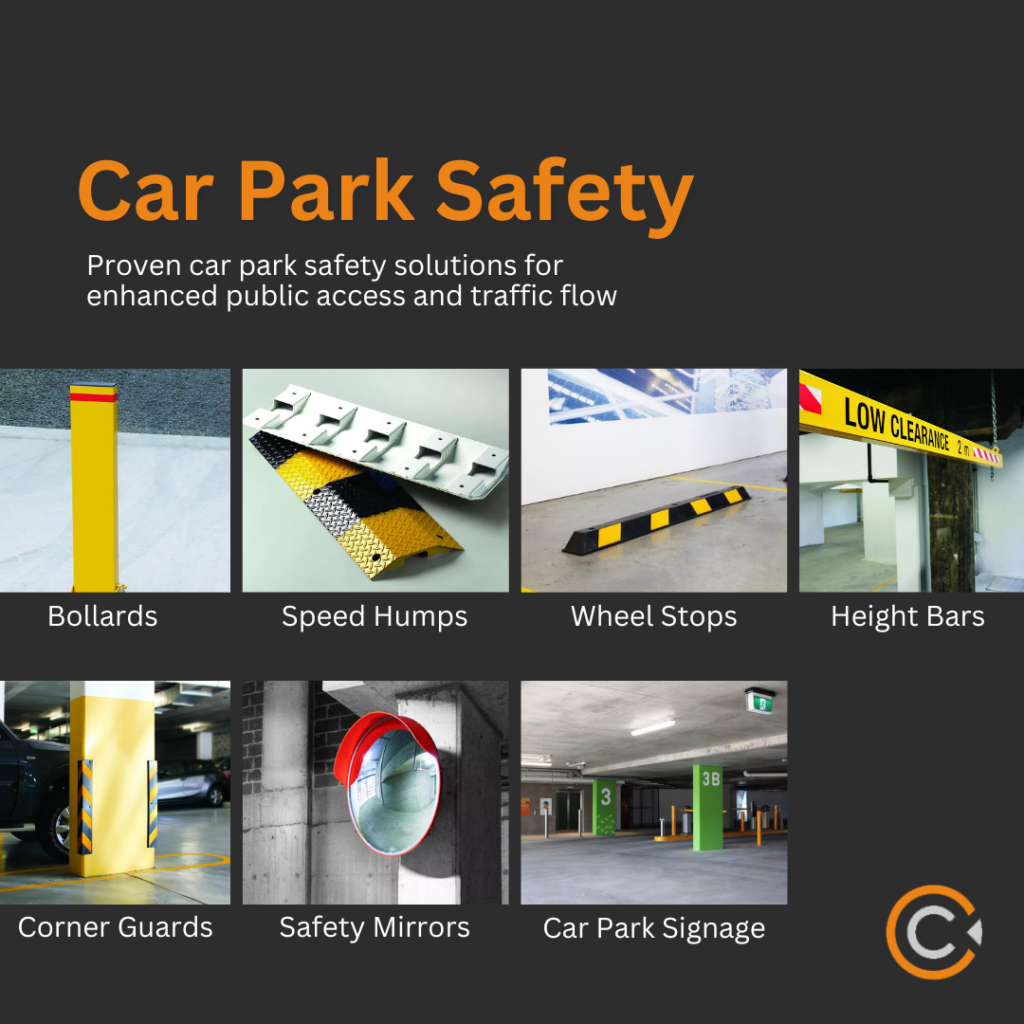Discover how wheel stops enhance the safety, accessibility, and compliance of your car park projects
The Australian Standards, along with other regulations, ensure that car parking facilities are safe and accessible for all drivers and pedestrians, including people with disabilities.
While safety and accessibility are the primary goals, following the standards also promotes efficient urban planning and traffic management and helps avoid costly legal issues from avoidable injuries and damage.
Wheel stops are part of a larger car park safety solution. In this article, we’ll explore the relevant Australian Standards and how you can ensure your project’s compliance.
What are Wheel Stops?
Wheel stops are small, highly visible barriers installed at the end of parking spaces to ensure vehicles stay within their designated spaces and protect other parking users and surrounding properties.
They are required to:
- Minimise kerb overhang, which can be inconvenient or hazardous to pedestrians.
- Prevent contact with an end barrier, high kerb or wall to avoid damage to the vehicle and other structures.
- Prevent vehicles from encroaching into an opposing parking space.
Types of wheel stops
Wheel stops are designed to be durable, withstanding the constant impact of vehicles over time. Each type of wheel stop is chosen based on specific needs, overall costs, and desired durability.
The three most popular types of wheel stops are concrete, rubber, and plastic.
Concrete Wheel Stops

- Weather, corrosion and rot-resistant
- Commonly installed indoors and outdoors across commercial and industrial settings
Rubber Wheel Stops

- Weather-resistant and heavy-duty, won’t chip or corrode
- Suitable for indoor and outdoor parking areas
Plastic Wheel Stops
- Made from recycled materials, weather-resistant and lightweight
- Best for light-duty or residential applications
Metal and composite wheel stops are also available, depending on the application.
Check out Classic’s wheel stop range.
Understanding Australian Standards for Wheel Stops
Designed to enhance car park safety and compliance, the Australian Standards AS2890 outlines essential requirements relevant to wheel stops, as well as speed humps, bike storage, and signage.
Specifically, AS2890.1:2004: Parking Facilities, Part 1: Off-street car parking, and AS2890.2:2018 – Parking Facilities, Part 2: Off-Street Commercial Vehicle Facilities provide detailed requirements for the design, layout, and operation of off-street car parks. AS2890.6:2022 also details further measures for off-street parking for people with disabilities.
Adopted by the Building Code of Australia (BCA), compliance with the Australian Standards AS2890 is mandatory for commercial, residential, and public projects involving new car park developments. The standards may also apply to renovations or expansions of existing car park facilities.
AS 2890.1: Parking Facilities – Part 1: Off-Street Car Parking
This standard provides guidelines on installing wheel stops in car parks to prevent vehicles from imposing on pedestrian walkways, adjacent structures, and other restricted areas.
Key Requirements for Compliance
Where necessary, wheel stops should be installed to control how far a vehicle travels into a parking space.
Compliant wheel stops must be:
- 90-100mm in height
- 1600-1700mm in width
- A contrasting colour to the surroundings
Where reverse-in parking is unlikely, e.g. angle parking, or one-way aisles, wheel stops should be positioned in the ‘front-in’ position. If reverse-in parking is likely, wheel stops should be positioned in the ‘rear-in’ position.
Wheel stop installation distance from a low kerb:
- Front-in: 620mm
- Rear-in: 900mm
Wheel stop installation from a high kerb or wall:
- Front-in: 820mm
- Rear-in: 1100mm
Note that the maximum height of wheel stops is 100mm unless installed to prevent contact with a kerb or wall higher than 150mm, in which it should be installed a further 200mm away (e.g. 820mm distance instead of 620mm).
Wheel stops should only be avoided if they encroach on the path of pedestrians moving to or from parked cars or crossing a car park for any other purpose.
AS 2890.6: Parking Facilities – Part 6: Off-Street Parking for People with Disabilities
In addition to the dimension and installation requirements outlined above, wheel stops should be installed in accessible parking spaces to prevent vehicles from impeding designated access aisles, ensuring unobstructed access for people with disabilities.
Importance of Compliance with Australian Standards
From local government authorities to architects and developers, AS 2890 assists in the planning and construction of parking facilities. It also allows car park operators to ensure a safer, more accessible space for all users.

To ensure compliance with Australian Standards, choose the right wheel stops and follow the above installation guidelines. In addition to meeting the mandatory requirements, conducting regular maintenance and routine inspections of your wheel stops is important. This is a proactive measure to check for signs of wear, tear, or damage that may impact their functionality and intended purpose.
Aside from risking public safety, a project that does not comply with the requirements of the Australian Standards can result in legal consequences, costing time and other valuable resources.
Successful Case Studies: Examples of Car Park Compliance for Your Inspiration
Goulburn Aquatics Centre, NSW
For this $28-million redevelopment, we partnered with FDC Construction to bring this state-of-the-art community facility to life.

Featuring a 25-meter indoor pool, cafe, gym, on-site parking, and other transformative upgrades, Classic supplied and installed our black & yellow wheel stops and powder-coated bollards, among other solutions.
Kalkallo Shopping Centre, VIC
In one of Melbourne’s booming suburbs, Foursquare Construction Management engaged Classic to ensure the safety and accessibility of this $70-million town centre in Kalkallo.

As part of their car park safety solution, we supplied and installed our black & yellow wheel stops, powder-coated bollards, rubber speed humps, and hoop bicycle rails.
Industrial Development, Clayton, VIC
This Clayton, Victoria project includes a 38,000m² three-unit development with 18,300m² of built area. It features a 5-star Green Star-rated facility with sustainability initiatives and wellness amenities.

Classic supplied and installed a combination of black & yellow wheel stops and concrete wheel stops to facilitate their car park requirements,
Hyatt Place, Caribbean Park, VIC
More than a business hotel, this Hyatt Place will offer an array of unique amenities, from spacious dining areas to full bar and lounge areas, to provide a luxuriously comfortable experience for their guests.

Working with Caribbean Gardens Pty Ltd, we supplied and installed our concrete wheel stops and hoop bicycle rails.
Trust Classic to Ensure Your Projects’ Compliance
Compliance with Australian Standards for car parks is crucial for reducing the risk of accidents, injuries, and property damage. By following the guidelines, you’ll ensure safety for all car park users and empower car park operators and facility managers to maintain the space’s overall accessibility and convenience.
At Classic, we support building professionals with end-to-end design, supply, and installation services across our floor, stair, and car park safety solutions. With local manufacturing and operations Australia-wide, our team offers tailored consultations to ensure your project is in expert hands.
You’ll also have access to our comprehensive Resource Hub, complete with technical product information, installation guides, and compliance advice—all in one place.

From complete car park safety solutions to stair nosings, tactile indicators, and bike storage, you can trust us to deliver compliant solutions on time, every time. Choose Classic for all your compliance needs and experience the difference our expertise and commitment can make.
Contact us on 1300 244 377 to speak to your local Classic rep today.



